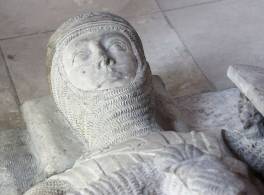Burials, monuments and exhumations are regulated by law. The design of memorials is controlled to make sure that churches and churchyards remain special places that everyone can appreciate.
We can help you understand the rules and practices so that you can guide the bereaved, or those wishing to install a new memorial.
Download our guidance
- Memorials in churchyard (337.72 KB)
- Burials (227.44 KB)

Who can be buried in your churchyard?
Unless the churchyard is closed by Order in Council under the Burial Act of 1853 the following people have a right to be buried in your churchyard:
- Residents in your parish
- Those whose names are on the church electoral roll
- Those dying in your parish
An incumbent can also allow anyone else to be buried in your churchyard. But you should get guidance from your Parochial Church Council.
Cremated remains
The same rights apply to cremated remains as with normal burials.
But if the churchyard is closed, then you can only bury them in an area specifically allowed by faculty.
Churchyard regulations
When speaking with the bereaved, it’s important to stress churchyard regulations:
- The interment of human remains is final. Exhumation only happens in exceptional circumstances
- The bereaved must follow the diocesan churchyard regulations
- Memorials can only be introduced in line with the regulations or with a faculty. That means that the size, materials and wording of any memorial have to be within the parameters of the regulations
- There is no automatic right to a memorial. Permission must be given before it is put in place
- Additional items are not always permitted depending on the terms of your diocese’s regulations (e.g. photographs, toys, windmills, etc)
You can obtain copies of the diocesan churchyard regulations at your diocese’s office.
Before the burial
Before a burial takes place, the Registrar of Births and Deaths or the coroner has to issue a certificate of disposal of the body.
The incumbent of the church should:
- Return the detachable portion of the certificate to the registrar within 96 hours of the burial
- And record the burial in the church registers in the normal way
Reservation of a grave space
People can reserve a grave space in your churchyard through a faculty. If space is limited, the consistory court might decide that this would be unfair to future burials.
You must assign a burial plot if a space has not been reserved. The executors will arrange the digging of the grave, usually through the funeral directors.
Graves don’t have to be a standard depth. But Orders in Council and local acts may specify a certain depth of soil above the coffin.
Where possible, dig a grave deep enough for further burials to take place (e.g. for family members).
Who can authorise a memorial?
Memorials can only be introduced in churchyards with the necessary authority:
- The incumbent can authorise gravestones
- A faculty is required for memorials or a gravestone of good design but outside the regulations
Remember:
Extra items such as photographs, toys and windmills might not be permitted, depending on your diocese’s regulations.
Choosing a gravestone
Each memorial is a private commemoration, but within a public location. So it’s important that the design takes the churchyard’s setting into account.
Churchyard regulations specify the size, materials and inscription on a headstone to make sure that it is appropriate and does not “stick out”.
Inscriptions should be simple and reverent. And an appropriate image can be etched or carved.
If the bereaved wants something a little different than the standard headstone, then you can suggest:
- Something more personal that blends in with the historic character of the churchyard
- A high-quality stone memorial with hand-cut lettering
- Something produced by an independent artist
If you are asked to approve a memorial that you don’t think is appropriate, contact your diocesan registrar for advice.
Designing an area for cremated remains
Unless there are only a few, it’s common for an area of the churchyard to be put aside by faculty for cremated remains. The best examples are where the area:
- Is enclosed
- Has a single, central memorial
- Has memorials incorporated into a wall or path
Use an entry in a book of remembrance or small individual memorials for memorialisation.
QR codes on gravestones
QR codes on gravestones need a faculty.
The person applying for faculty should know that there may be concerns about linking a gravestone to a website because the website is out of the minister’s and churchwarden’s control and it could contain material that is defamatory or inconsistent with Christian teaching.
Ownership of war memorials
The majority of war memorials were paid for by public subscription through a committee.
You can only establish their ownership if a formal transfer of ownership happened after the memorial was put up. Most of the time, this is not possible because the committee was dissolved after the work was done.
For war memorials in churches and churchyards, the church traditionally maintains them, while war graves are maintained by the Commonwealth War Graves Commission.
Before you do any work to a memorial in your church, you need to apply for faculty.
